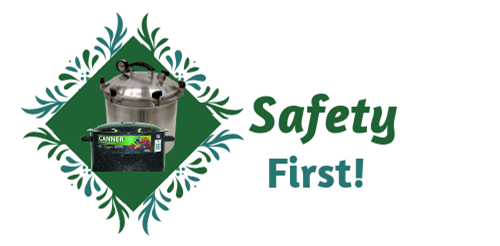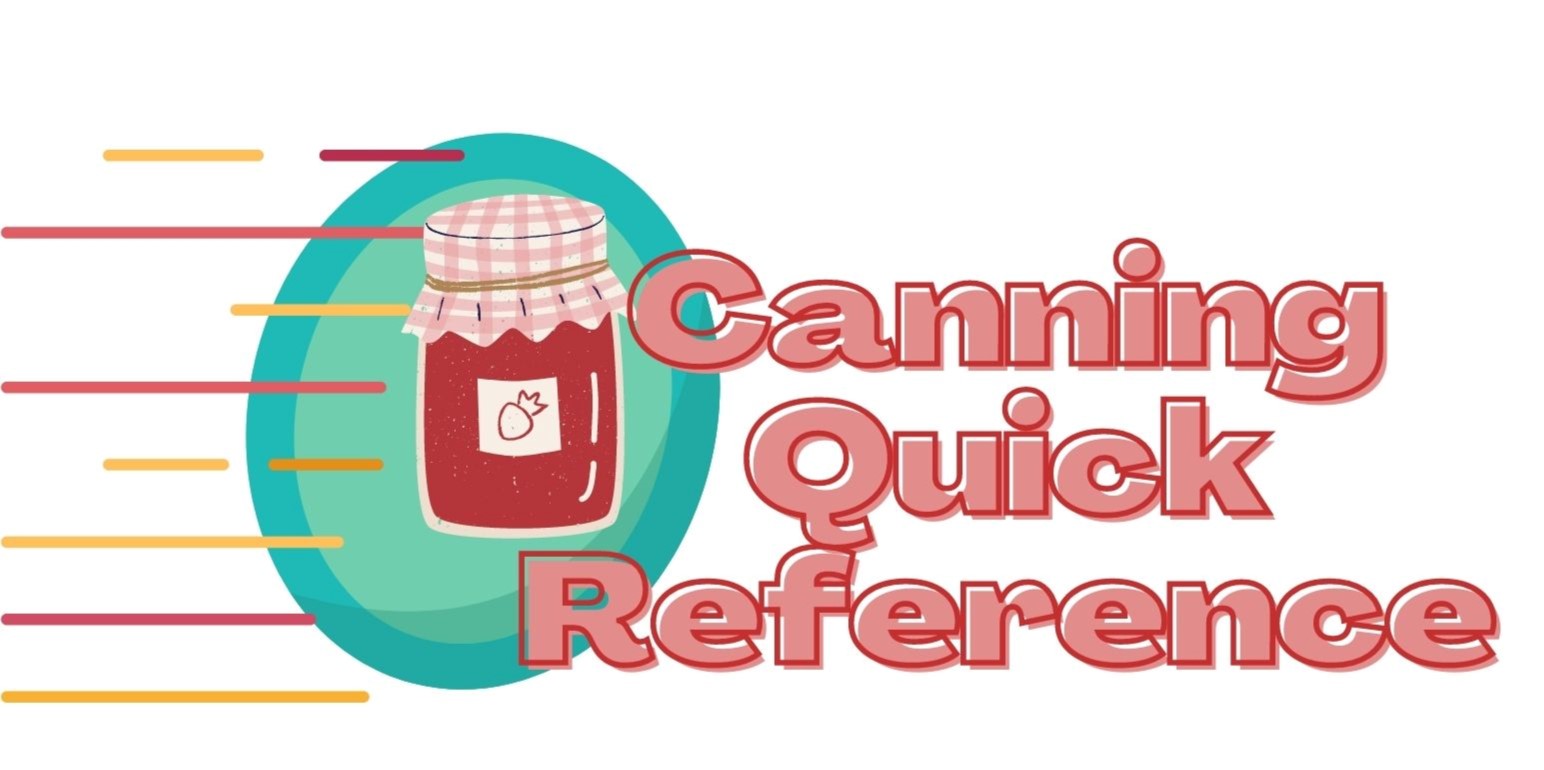
How to Preserve Food Safely
by Elizabeth Jones
2019

Botulism is a medical emergency. If you or someone you know has symptoms of foodborne botulism, see your doctor or go to the emergency room immediately.
You cannot see, taste, or smell botulism.
But
There are ways to protect yourself, your family, and others when it comes to home-canned foods by following these tips:
1. Use Proper canning techniques.
2. Use the right equipment for the kind of foods you are canning.
3. When in doubt, THROW IT OUT!
4. NEVER, NEVER taste food to determine if it is safe!

Botulism Information
What is Botulism
“Botulism is a rare but serious illness caused by a toxin that attacks the body’s nerves and causes difficulty breathing, muscle paralysis, and even death. This toxin is made by Clostridium botulinum and sometimes Clostridium butyricum and Clostridium baratii bacteria. These bacteria can produce the toxin in food, wounds, and the intestines of infants.
The bacteria that make botulinum toxin are found naturally in many places…These bacteria make spores, which act like protective coatings. Spores help the bacteria survive in the environment, even in extreme conditions. The spores usually do not cause people to become sick, even when they’re eaten. But under certain conditions, these spores can grow and make one of the most lethal toxins known. The conditions in which the spores can grow and make toxin are:
- Low-oxygen or no oxygen (anaerobic) environment
- Low acid
- Low sugar
- Low salt
- A certain temperature range
- A certain amount of water
For example, improperly home-canned, preserved, or fermented foods can provide the right conditions for spores to grow and make botulinum toxin. When people eat these foods, they can become seriously ill, or even die, if they don’t get proper medical treatment quickly.” (CDC About Botulism)
Protecting Yourself and Others from Botulism
How can I keep myself and others safe when it comes to home-canned foods?
Many cases of foodborne botulism have happened after people ate home-canned, preserved, or fermented foods that were processed incorrectly and contaminated with the Botulism toxin.
You cannot see, taste, or smell botulism.
You can take steps to protect yourself, your family, and others when it comes to home-canned foods by following these tips:
- Use proper canning techniques.
- Never alter a recipe.
- Use the right equipment for the kind of foods that you are canning.
- When in doubt, throw it out!
Pressure canning is the only recommended method for canning low-acid foods. Foods with low acid content are the most common sources of home-canning-related botulism cases. Low-acid foods include almost every vegetable, some fruits, milk, all meats, fish, and seafood. Do not use boiling water canners for low-acid foods because they will not protect against botulism.
How to make your home-canned vegetables, and meats safe.
- Use a recommended pressure canner that holds at least four one-quart jars sitting upright on the rack.
- Be sure the gauge of the pressure canner is accurate. Gauges may be checked at many county Cooperative Extension offices. (See FAQs to find a FACS extension office near you.) Clean lid gaskets and other parts according to the manufacturer’s directions.
- Vent the pressure canner before pressurizing and follow recommended cooling steps.
- Use up-to-date process times and pressures for the kind of food, the size of the jar, and the method of packing food in the jar.
Symptoms of Botulism
Botulism is a medical emergency. If you or someone you know has symptoms of foodborne botulism, see your doctor or go to the emergency room immediately.
Symptoms may include the following:
- Double vision
- Blurred vision
- Drooping eyelids
- Slurred speech
- Difficulty swallowing
- A thick-feeling tongue
- Dry mouth
- Muscle weakness
Canning Basics
Make sure you are using the right method and equipment for canning. Botulism, clostridium botulinum is found in soil. It can survive and grow, creating a toxin with incorrect canning. This toxin can affect the nerves, and cause paralysis and death. So, it is necessary to follow correct guidelines laid out by the National Center for Home Food Preservation and Center for Disease Control and Prevention.
There are 2 methods of canning: Water Bath and Pressure. How you know which method to use is based on how acidic the food is. The acidity level (pH) cut-off is 4.6. HIGH acid foods have a pH value LOWER than 4.6 and can be processed by using the water bath method. LOW acid foods have a pH value HIGHER than 4.6 and MUST be processed by a pressure caner to kill botulism. You can use pH test strips to check acidity levels. See the Acidity Level Chart for more information.
Tomatoes are right on the border of the 4.6 level. Some varieties have a higher pH and some varieties have a lower. Use Guide 3 from the Canning Guides to know how much lemon juice to add to raise the pH level of the tomatoes to keep your family safe.
Not all presser cookers are the same. Only Pressure Caners with the Underwriters Laboratory (UL) seal of approval and can hold at least 4, one-quart, jars sitting upright on the rack are safe to use.
If you suspect spoilage, THROW IT OUT!
Spoilage is indicated by:
NEVER shake the jars before opening them. Yon won’t be able to see the indicators of spoilage if you do.
1. The container is leaking, bulging, or swollen.
2. The container looks damaged, cracked, or abnormal.
3. The container spurts liquid or foam when opened.
4. The food is discolored, moldy, or smells bad. (Just remember, you cannot see, taste, or smell botulism. So, if you doubt it is good, THROW IT OUT–Safety First!)
5. If any spoiled food spills, wipe up the spill using a solution of 1/4 cup bleach for each 2 cups of water.
Never taste food to determine if it is safe. Do not taste or eat food that is discolored, moldy, or smells bad. Do not taste or eat food from cans that are leaking, have bulges or are swollen, or look damaged, cracked, or abnormal. Do not taste or eat food from a can that spurted liquid or foam when it was opened. You cannot see, taste, or smell botulism.
Canning Methods
Pressure Cooking Method
Water Bath Method
Other Food Preservation Methods
Frequently Asked Questions
Are all pressure cookers okay to use for canning?
-NO.
-Only pressure cookers that have the Underwriters Laboratory (UL) seal of approval are safe to use for canning.
How do I make sure my pressure cooker is safe to use?
–Find a GA FACS Agent near you and get your caner checked out!
Can I use any kind of salt for canning?
-It’s not recommended but, you can use other kinds of salt. HOWEVER, there are some guidelines you must follow if you are substituting.
First, you can’t always just interchange the measurements of one salt for another. The grain size is usually different and if you measure tablespoon for tablespoon, you might actually be getting a different salt concentration than is intended in the recipe. As you probably know, in fermented canning recipes the salt concentration should NEVER be altered or you may not be safe. (The salt is there to prevent bad bacteria including botulism.) So unless you know the weight needed of the pickling salt and can weigh an equal amount of an alternative, you just might be altering the concentration…and that could be dangerous.
The one exception to this is kosher salt.
Kosher Salt: is commonly interchanged with pickling salt because most are also pure salt with no additives or anti-caking agents. (Note: A few brands of kosher salt DO have other ingredients, so always check the label if you want a clear brine. It should only say “salt” and nothing else.) And if you can find a “fine grain” kosher salt, all the better.
The Bottom Line About Salt:
The bottom line is that if you can get pickling salt, buy it! It is available anywhere that canning supplies are sold and is also available in cooking stores and even online. It is by far the best salt for canning as it helps prevent spoilage whereas another kind of salt can lead to spoilage. Remember, most recipes that are using salt as an ingredient are proportioned for pickling salt.
What are the different kinds of canning?
-There are 2 methods of canning. One is the water bath method. The second is the pressure canner method.
When can I use the water bath method?
-The Water bath method is used for foods with high acidy. High acidy is crucial to canning safety because relative acidity determines the temperature at which microorganisms will be killed. Foods with a PH of 4.6 or lower are considered high acid. Some fruits straddle the high/low acidy fence such as tomatoes. In these cases, add lemon juice or citric acid.
Why must I use a pressure canner?
-The only protection against botulism food poisoning in low acid foods is the heat applied during canning. Using traditional methods that were handed down over generations or using boiling water instead of a pressure canner can be deadly. Clostridium botulinum can form spores that are very, very heat resistant. Even hours in the boiling water canner will not kill it. Left alive after canning, the germ will grow and produce a deadly toxin.
Improperly canned vegetables & meats can contain the deadly botulism toxin without showing signs of spoilage. You can’t taste it or smell it, so you don’t even know it’s there, and it can kill you. The bacteria must be killed during the canning process for safe storage. See Jefferson.prlib.org for safety guides. And remember, pressure cookers are not the same as pressure canners. Only use a presser canner that has the Underwriters Laboratory (UL) seal of approval for canning
